EDITOR’S NOTE — It was just after 2 a.m. on Jan. 31, 1968, when the crackle of celebratory fireworks in South Vietnam’s capital gave way to the pounding of machine guns, grenades and rockets. As the country celebrated Lunar New Year, communist forces launched a wave of surprise attacks that became known as the Tet Offensive and would change the course of the Vietnam War.
From Saigon to Hue to Nha Trang, North Vietnamese and Vietcong forces attacked the major population centers that they had until then avoided. From the jungles and rice fields of the north, an estimated 80,000 fighters brought the war south with coordinated attacks on 39 of South Vietnam’s 44 provincial capitals, 64 district headquarters, nearly every allied airfield and Saigon.
In Saigon, fighting raged across the city, including an ambitious attack on the American Embassy.
While the battles went on for a month in some place like Hue, the Tet Offensive was ultimately seen from a strictly military standpoint as a defeat for the communist forces. But the campaign had a lasting impact on the war, raising questions about Washington’s strategy and deepening the American public’s doubts about U.S. involvement in the campaign.
The AP’s Peter Arnett reported on the Vietnam War from 1962 until its end in 1975. On the 50th anniversary of the Tet Offensive, the AP is publishing this edited extract from his book “We’re Taking Fire: A Reporter’s View of the Vietnam War, Tet and the Fall of LBJ.”
___
TET: THE FIRST 36 HOURS
The blast of strings of exploding firecrackers jerked me awake as Vietnamese neighbors continued their celebrations into the early hours of the morning. It was Saigon, January 31, 1968, the first day of the year of the traditional lunar calendar, Tet Nguyen Dan, and the most important Vietnamese festival. Amid the cacophony I noticed a loud, methodical rat-tat-tat that shook our apartment shutters as though someone was banging on them with a hammer. I’d heard that sound before in the battlefield, the roar of a heavy-caliber machine gun, and it seemed to be shooting up Pasteur Street just three room-lengths away. A weapon that lethal had not been discharged in Saigon since the overthrow of President Ngo Dinh Diem four years earlier.
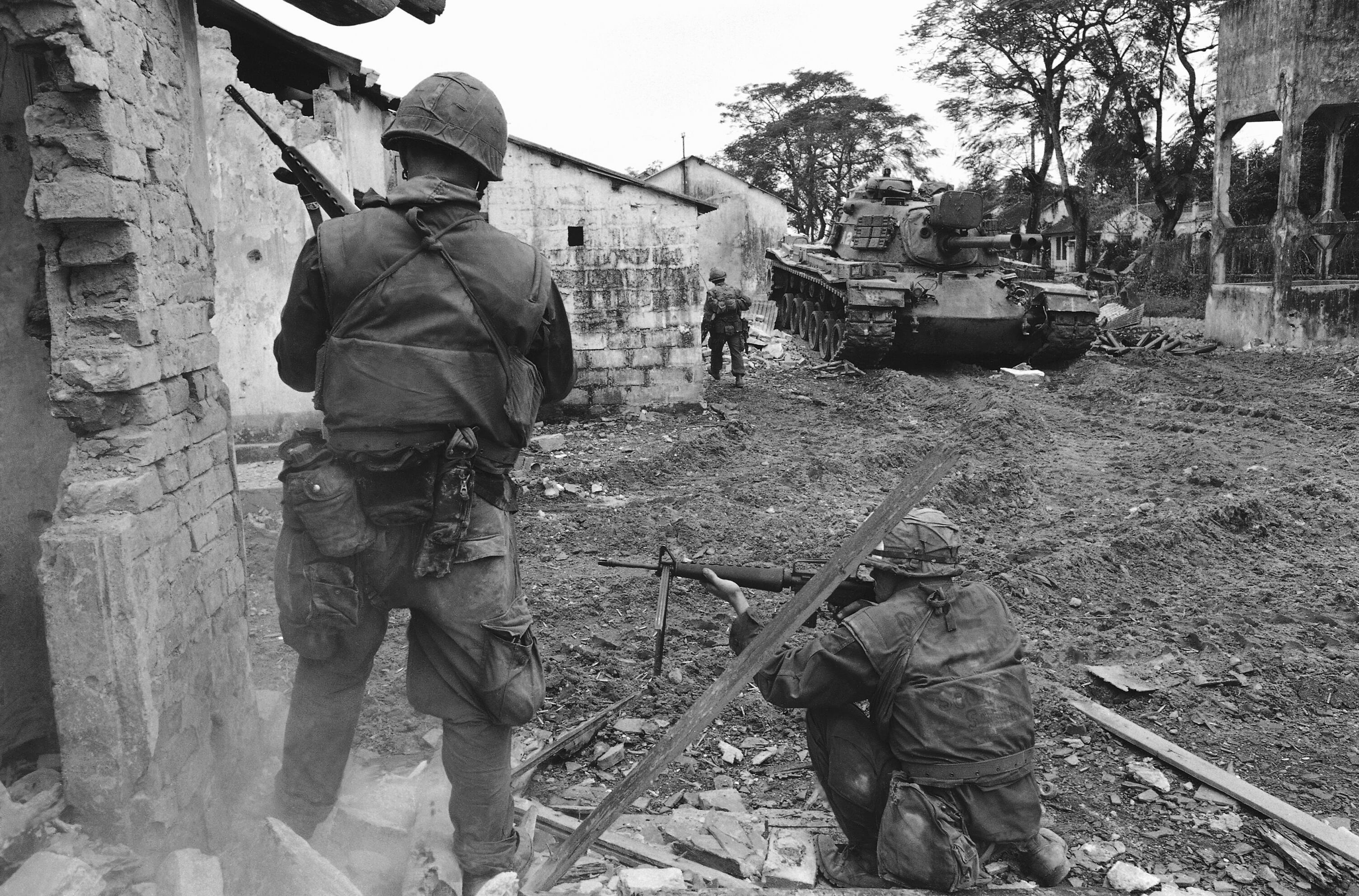
I opened my bedroom window and watched as war came to Saigon from the jungles and paddy fields and peasant villages where it had lingered for years. Red tracer bullets zipped through the sky and firefights were erupting near the centers of power in South Vietnam’s capital, the presidential palace and the American Embassy. As the sounds of exploding grenades and rockets vibrated through the darkness, I bundled my wife Nina and my young children, Elsa and Andrew, and our maid into the bathroom, which I hoped was safer than the rest of our small apartment, and I covered them with mattresses from the beds. I phoned The Associated Press office, and bureau chief Robert Tuckman answered, his voice high-pitched and excited: “They’re shelling the city, for God’s sake.” I told him I was on my way.
I wasn’t the only one so rudely awakened in total surprise at around 2:30 that morning. Only those in the know — the attacking Vietcong guerrillas and North Vietnamese military forces and their allied clandestine networks in the city — had any idea of what was happening. By quietly moving combat troops through the supposedly secure countryside into the heart of Saigon, they were able to strike without warning. Gen. William Westmoreland, the increasingly confident commander of all American combat forces fighting in Vietnam, was asleep in his comfortable villa at Tran Quy Cap street when attacks began all around his neighborhood.
Just nine weeks earlier, the general visited the United States on the orders of President Lyndon Johnson to participate in a “success offensive,” a concerted effort to bolster public support for the war. In an address at the National Press Club, he asserted that the Vietcong were “unable to mount a major offensive” and that the point was reached “when the end begins to come into view.” But on this early morning, Westmoreland was stuck, unable to reach his Saigon headquarters as gunfire roared in the street outside. By telephone, he learned of the spiraling crisis, particularly a fierce attack on the six-story American Embassy at Thong Nhut street several blocks away.
Ambassador Ellsworth Bunker was similarly blindsided by the ferocity of the enemy attacks, particularly the assault on his embassy. He was asleep in his villa four blocks away when his security team rushed into his bedroom and ushered him down to the basement in his pajamas. Wearing his bathrobe, he was soon loaded into an armored car and driven to a safe house. Bunker had been in South Vietnam less than a year, and in that time, he had worked closely with Westmoreland and endorsed his views.
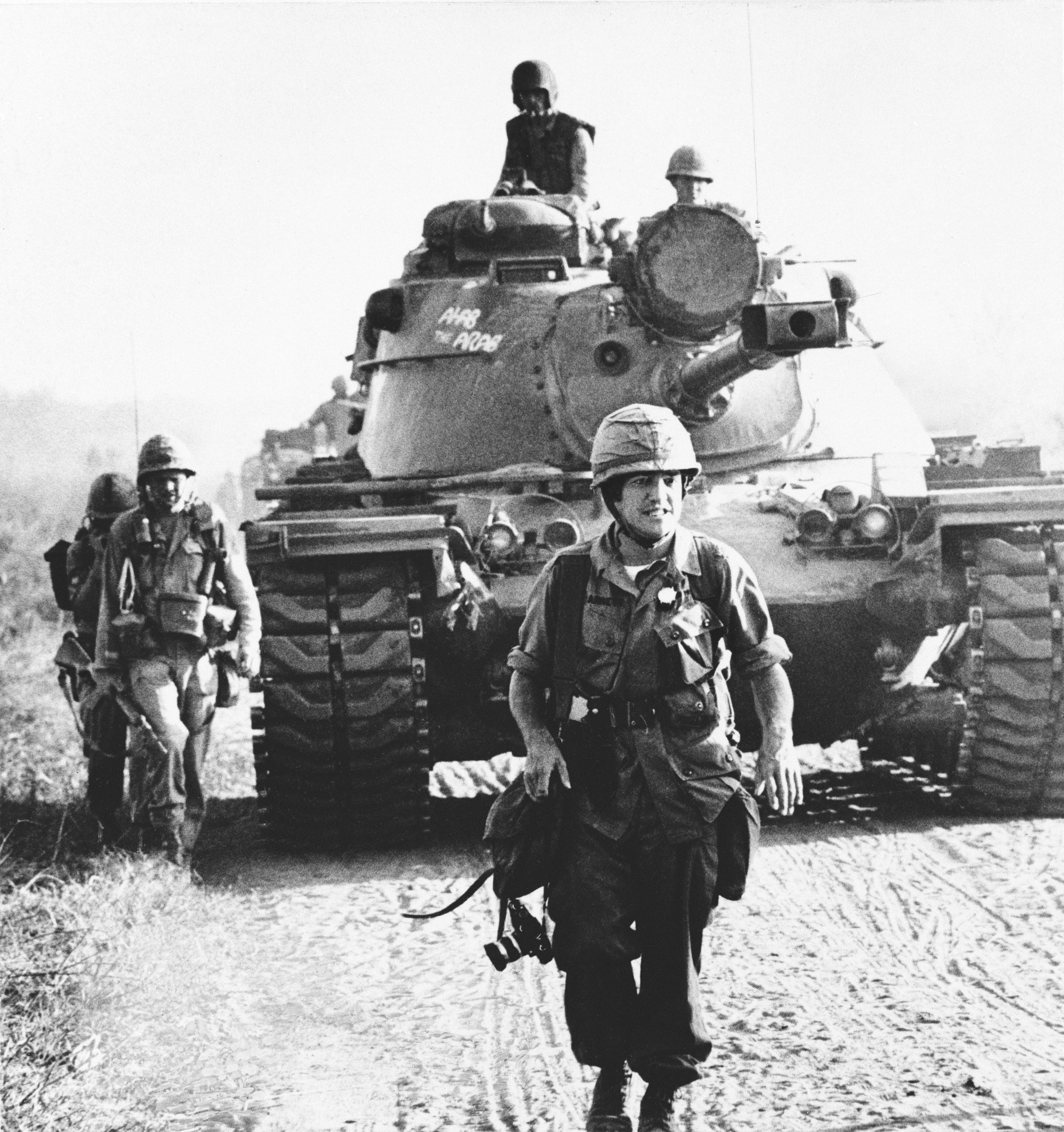
In Washington, D.C., half a day behind Vietnam in time, it was the early afternoon of January 30. President Johnson was presiding over a meeting of his closest security advisers, their biggest Vietnam concern the struggle to avoid the loss of the U.S. Marine combat base of Khe Sanh that over the weeks had been threatened by a growing number of North Vietnamese troops. Nearly half of all American combat troops in Vietnam were being moved to the northern provinces to support Khe Sanh and other border bases. It was during the meeting that President Johnson first heard the alarming news from Saigon.
His special assistant for national security affairs, Walt Rostow, returned after taking a call from the National Military Command Center. It was 2:35 p.m. Rostow, a hawk on Vietnam who late in 1967 had used the phrase “light at the end of the tunnel” to describe the war policy’s successes, announced, “We have just been informed that we are being heavily mortared in Saigon. The presidential palace, our bachelor officers’ quarters, the embassy and the city itself have been hit.”
The minutes of the meeting record President Johnson as responding, “This could be very bad. What can we do to shake them from this? ... What comes to mind in the way of retaliation?”
Defense Secretary Robert McNamara, the primary architect of early war policy whose growing doubts about the morality of the American effort had led to his announced replacement, gave little weight to the initial information, suggesting it should be handled as “a ‘public relations’ issue.”
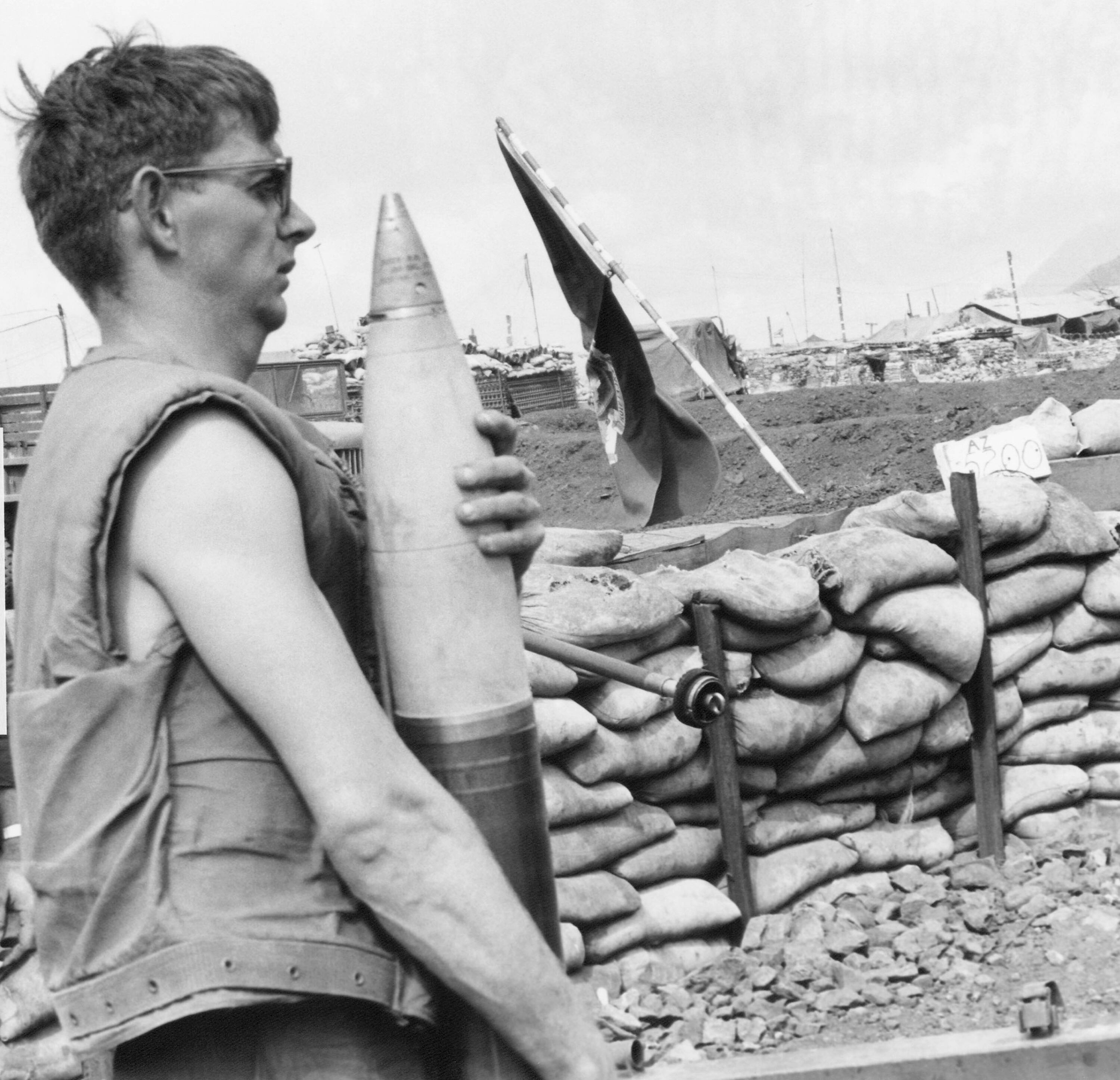
Around the same time, William Colby, the CIA’s chief of the Far East Division, at work at the agency’s Langley, Virginia, headquarters, received a flash message from Saigon station reporting that “a violent attack against the American Embassy is in progress with the attackers possibly within the embassy itself.” Colby advised them in a flash return message that the Communications Center should button up its steel doors. Colby was a former CIA station chief in Saigon, a confidant of the slain President Ngo Dinh Diem, and a proponent of a counter insurgency strategy that relied less on American combat troops. Within days, he would be on his way to South Vietnam to help pick up the pieces of a crumbling policy.
As the 3 million people of Saigon became abruptly aware of the brutal enemy intrusion in their Tet holiday celebrations, there was confusion within the South Vietnamese security ranks. Many of the military police primarily responsible for city protection were at home celebrating with their families. President Nguyen Van Thieu, who was also the commander of Vietnam’s armed forces, was on a Tet holiday with his family and could not be immediately located. A month earlier, the American military command had handed over the security of the nation’s capital entirely to the Vietnamese paramilitary police forces, and Thieu’s authority was necessary to facilitate supporting troop movements from outside.
Vice President Nguyen Cao Ky complained later, “Catastrophe loomed. In expectation of the usual Tet truce, half of our armed forces had gone on leave. To make things worse, most of our army’s combat forces were not deployed in or near big cities.” General Westmoreland was particularly unhappy about President Thieu, who had been informed of security concerns in the northern region and had agreed to cancel the Tet cease-fire there a day earlier. The day passed with no notice of the cancellation, and according to Westmoreland, “I telephoned the American Embassy to find that the South Vietnamese government had provided its press officer with a release but that the press office was shut tight, closed for Tet. President Thieu had departed to pass the holidays in My Tho, his wife’s hometown in the Mekong Delta. Such a lackadaisical attitude on the part of the government was shocking and frustrating yet indicative of the state of mind, to near euphoria, that envelops the Vietnamese at Tet.”
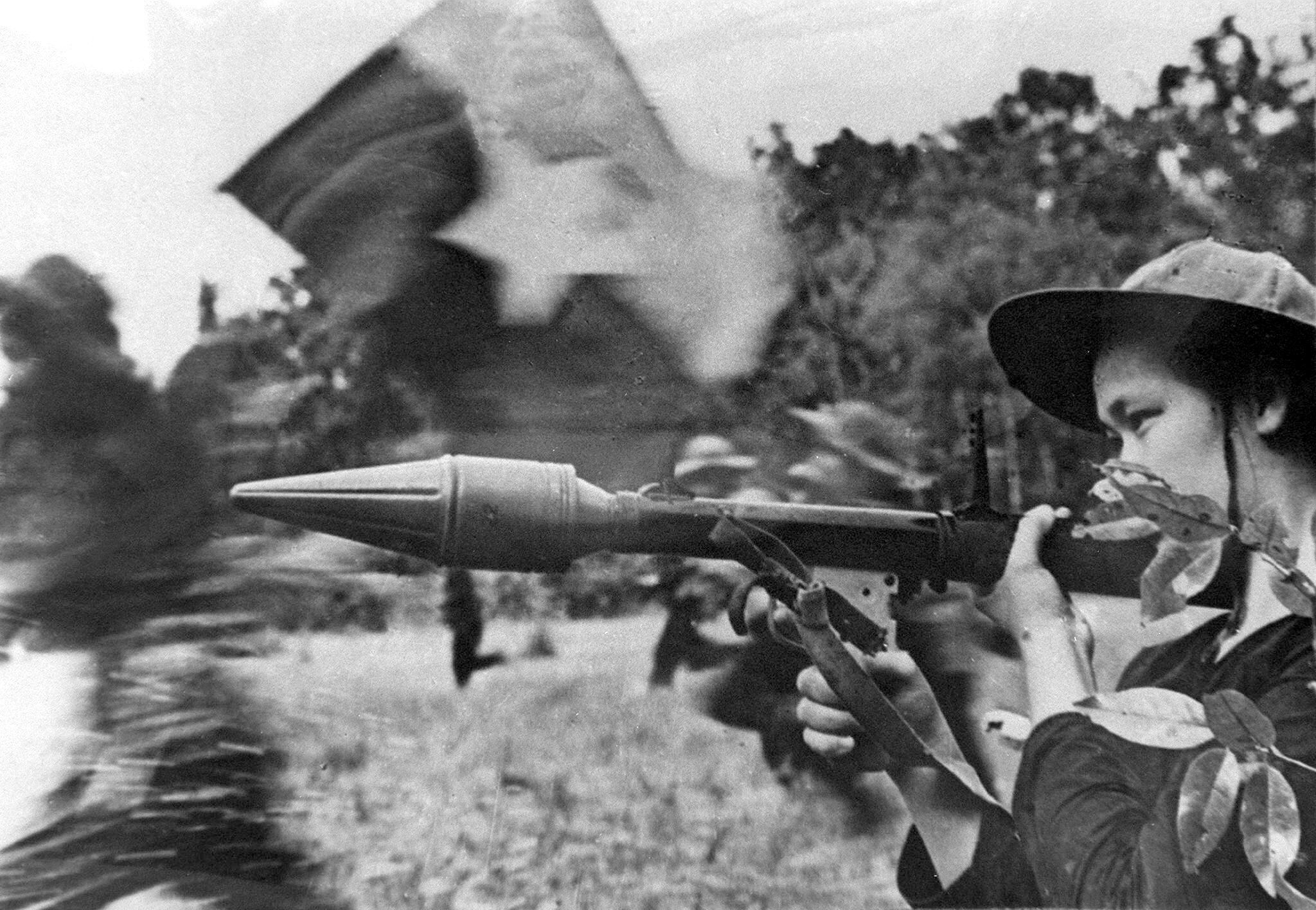
Not all the Vietnamese, however, were euphoric celebrants, certainly not the Vietcong who were violating their own announced seven-day Tet truce with surprise attacks across the country. We would soon learn that the Saigon attacks were just the point of the spear. The Vietcong and the North Vietnamese, who had until now avoided attacking major population centers, were using an estimated 80,000 fighters in a coordinated assault against 39 of South Vietnam’s 44 province capitals, 64 district headquarters, almost every allied airfield, and Saigon. A puzzle was that the only American installation attacked was the embassy.
I said goodbye to my family to begin my reporting day, and opened my apartment door as a burst of heavy machine-gun fire flashed through the darkness in the direction of the presidential palace two blocks away. I waited for a break in the shooting and stepped out into the lamplight, raising my arms in a friendly gesture to the invisible gunners behind the sandbags just down the street. I was in shirt sleeves and slacks and I smiled and shouted “journalist” in Vietnamese. There was no reaction, so I just walked past them on my way to the AP office. Our staff were on the telephones, reporting what best they could to our news headquarters in New York City. The American Embassy was under attack; so was Tan Son Nhut airport and the main Saigon radio station, the presidential palace, and Vietnamese security installations. We needed eyewitness stories, bureau chief Tuckman told me.
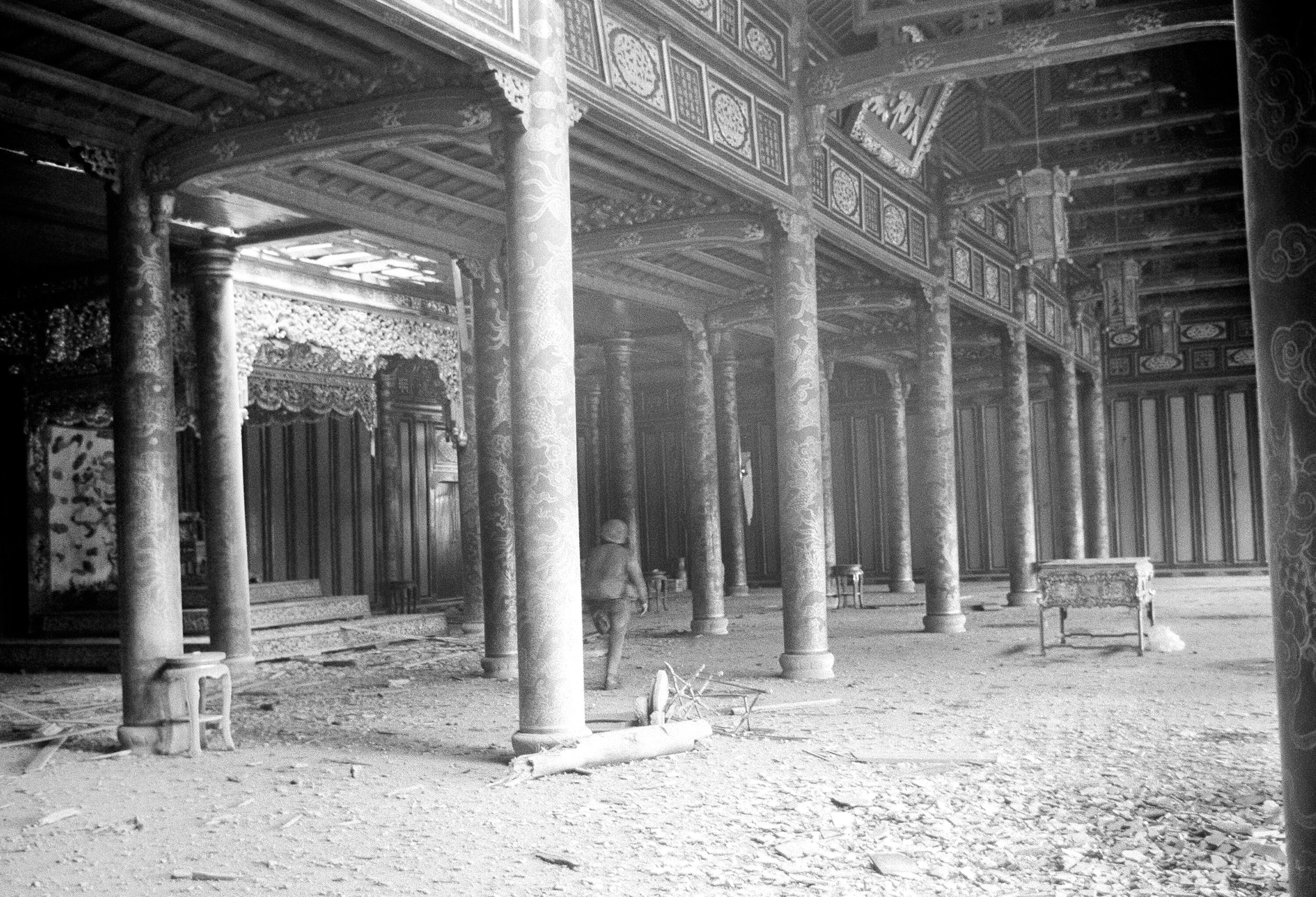
I was joined by reporter colleague John Nance and photographer Joe Holloway, grabbing the keys to the office mini-jeep and setting off across the embattled city, the night sky bright with tracer bullets and the swinging arcs of parachute flares. We drove up a side street behind the presidential palace to get closer to the action. A South Vietnamese soldier stepped out in front of the jeep and signaled us to turn back, indicating that the Vietcong had moved into a nearby unfinished building, after their attack by rockets and hand grenades against the palace gate had been repulsed. As we turned, a hail of bullets splattered the street around us, sending us quickly on our way.
One of the Vietcong combatants who fired at us was a woman, Vu Minh Nghia, 21 years old, who was among the eight Vietcong attackers who survived. She told her captors her assault team had sneaked into Saigon the previous evening, worried by the last-minute order to attack the well-defended palace. They were briefly fighting around the gate, she said, before retreating to the nearby house after seven of their number were killed. They were shooting at anyone who approached until later in the day when they gave up.
When I returned to the AP office at 4:30 a.m. I received a call from Barry Zorthian, the chief of the joint U.S. information office, offering me a scoop, a phone interview with a top American official trapped in his two-story cottage in a corner of the courtyard of the embattled embassy. “We just want you to get the story straight, Peter,” Zorthian said. There were gunshot sounds and explosions in the background when I interviewed George “Jake” Jacobson, the veteran embassy coordinator, who told me that several enemy commandos had blown a hole in the embassy wall an hour or so earlier and were roaming the grounds outside his cottage, firing bazooka shells at the façade of the shiny, new eight-story embassy chancery building. And the attackers were exchanging fire with snipers in buildings across the street.

“They know I am here,” Jacobson, a courtly older man, told me in a whisper on the phone. He said his upstairs bedroom windows were already shot out by a rocket. He had armed himself with a hand grenade for a last-ditch stand. He was a cool one, a veteran of nine years’ service in Vietnam. His last comments to me were that, “The Vietcong are calculating a big splash all over the world with their activities.” I was intrigued by these comments from a senior official crouching in his bedroom and fearing for his life but also figuring out a credible explanation for what was going on — that it was a communist publicity stunt. As I wrote the story for the AP, I could hardly believe the audacity of the Vietcong, who were not only assaulting the American Embassy, but also launching vigorous attacks against a dozen other targets across Saigon, all at a time when conventional wisdom had them pushed to the ropes.
The fate of George Jacobson and that of the embassy itself in the developing battle became an immediate priority for our coverage because it was the highest profile target in the first hours of the offensive, and it was just five blocks away from the AP office. We set off for the embassy on foot, heading up Tu Do street past the towering red-brick Roman Catholic basilica, noticing security men in the adjoining park hiding behind trees; but they made no effort to stop us.
Bursts of rockets and the crack of small arms drew us down Thong Nhut Boulevard, past the headquarters of the Texas construction giant RMK-BRJ to Hai Ba Trung street, and the corner of the block where the embassy, behind an eight-foot concrete wall, loomed above us in the darkness. We edged along the street and crouched down as small as we could make ourselves. The boulevard was a shooting gallery; gunfire crackled over our heads and thudded into tree trucks and walls. American military police from the 716 battalion had occupied an upper floor of an apartment building across the street and were directing fire into the embassy grounds. The Vietcong inside were returning fire.
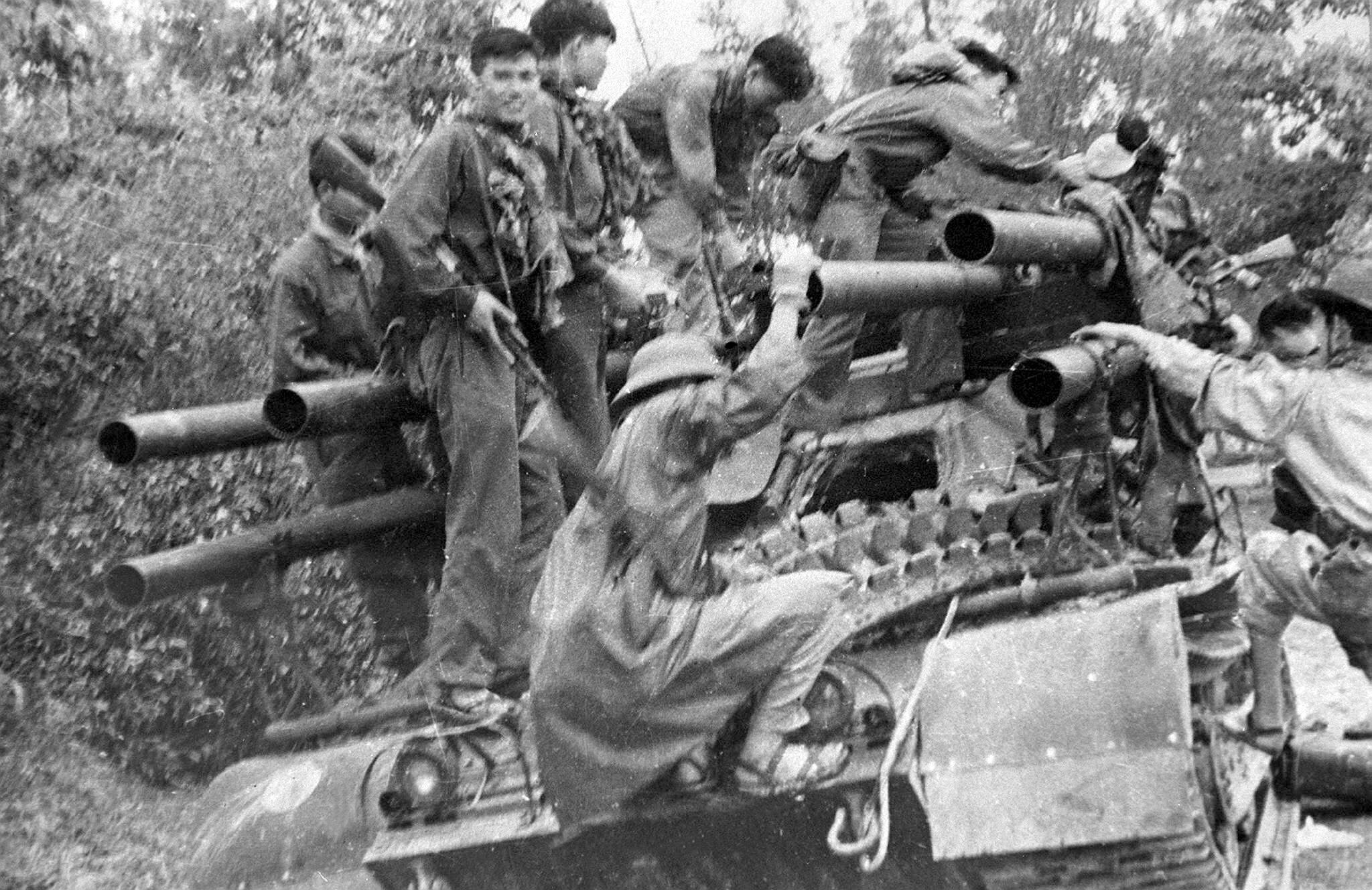
The senior Marine guard at the embassy, Staff Sergeant Ronald Harper, was taking cover in the floodlit lobby when a rocket smashed into a window next to the wooden door, wounding a fellow Marine in the arms, face and legs. A few seconds later the attackers dropped a hand grenade through the broken window as another rocket exploded against the door.
Harper said later, “I figured the Vietcong were coming in. I moved back to the armory to get my 9mm Beretta submachine gun, then I helped move my buddy upstairs. I figured we were in for it.” He returned and fired a test burst from his machine gun and backed into the corner of the lobby, able to see through the steel grills in the open window. As more rockets thumped into the fragile concrete latticework on the embassy façade, Harper said, bits of searing, hot metal took their toll on these trapped in the embassy. “One Marine guard fell dead; six others were wounded,” including himself.
The first glow of a gray dawn lit the scene. We saw a bullet-riddled black Citroen sedan in the middle of the street, its driver slumped over the steering wheel. Outside the embassy gate were two other immobilized vehicles. There was concrete rubble scattered near them and a haze of dust in the air from the blasting the Vietcong had done to make their way into the embassy grounds.
I wondered what had happened to George Jacobson, and I was told by a Marine captain, Robert O’Brien, who had arrived with Marine guard reinforcements, that he had been in radio communication with Jacobson and the handful of embassy staffers in the chancery on overnight duty. He said, “I’ve relayed to them the word from command headquarters they would have to hold out because a counterattack would be too dangerous in the darkness.”
Inside the embassy, the duty officer, 32-year-old Allan Wendt, was asleep in a cot in room 433 on the fourth floor of the embassy when the attack began. He later recalled, “Suddenly the building was hit by a loud explosion. Automatic weapons fire broke out and rockets began to thud into the building. I quickly retreated to the more secure and better equipped communications room where a specialist, James A Griffin, was on duty. A call to the ground-floor Marine security guard post revealed that at least one Marine guard, Staff Sergeant Ronald W. Harper, was alive and functioning.
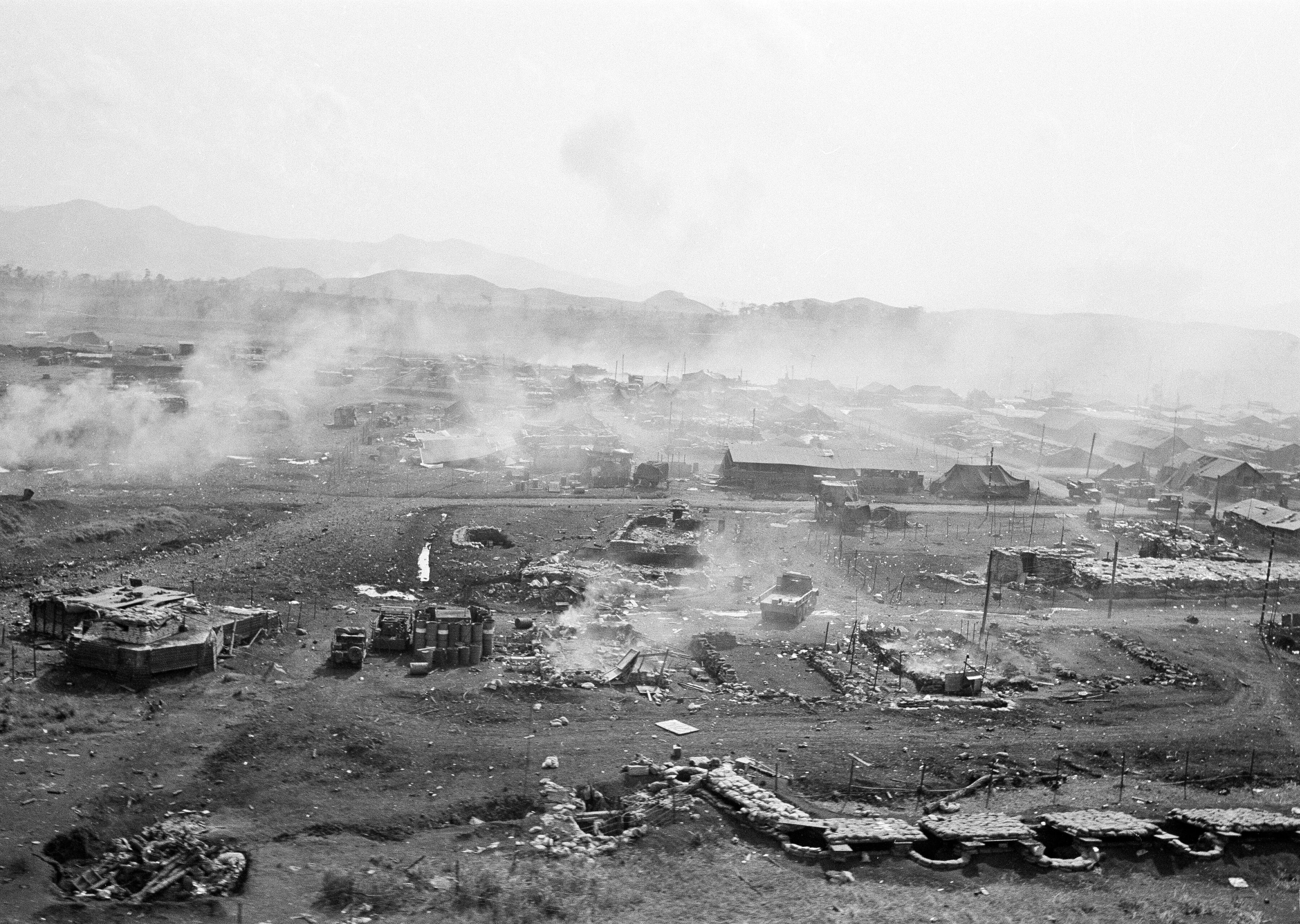
The Vietcong attackers, at that point, were not in the building. I placed and received phone calls from the White House Situation Room, the State Department operations center, and the American military command in Saigon. I spoke regularly to embassy officers at the off-site command post setup by Ambassador Bunker. As the siege wore on, we pleaded with the U.S. military command for relief. We were told an armored column was on its way. It never arrived. One helicopter finally did land on the roof and evacuated a wounded Marine. But to my consternation, I also discovered that two armed American military personnel including a Marine whose presence I had not detected, also took off on the chopper, leaving the lone Marine on the ground floor and a few civilians and me to fend for ourselves.” (There is no available record on whether this incident was followed up.)
As the morning brightened, John Nance and I, still concealed near the outside wall, saw military policemen crawling along the exposed gutters and the sidewalk next to the embassy wall up ahead of us, moving into position for a counterattack while others were gathering in formation to assist them. A dozen Huey helicopters came in low over the gardens at the Saigon zoo end of the street, heading towards us. I realized they were going to attempt an infantry assault against the embassy.
Nance, who had taken shelter behind one of the immobilized vehicles, watched as an MP rose to his feet and slammed his shoulder against the wrought iron embassy gate. It swung open and the military policemen rushed inside as the roar of exploding hand grenades and automatic weapons fire erupted. I could see the first of the helicopters hovering over us, trying to land on the embassy roof. In a barrage of gunfire from the courtyard it pulled away and was gone, and soon many of the soldiers who had stormed through the gate were back outside, pointing to the middle floors of the chancery building. Not only were the Vietcong inside embassy grounds, but they had apparently penetrated the embassy itself and were upstairs. I asked a disheveled officer if he was sure and he said, “My god, yes, we’re taking fire from up there. Keep your head down.”
I ran to the construction building down the street where the night porter let me use the phone to send my story. Ed White calmly took my dictation, and I returned to the corner of Hai Ba Trung where newspaper and television colleagues were assembling to cover one of the most sensational actions of the whole war. An hour later, a second helicopter assault was launched, and we saw soldiers from the U.S. Army’s 101st Airborne Division jumping to the chancery roof and beginning their descent through the building. I saw correspondent Howard Tuckner of NBC and his cameraman Vo Huynh follow a military police squad through the front gate into the embassy grounds, and we were all soon joining them, gasping at the evidence of the fierce struggle inside.
A large hole had been blasted through the protective wall, the Great Seal of the United States was bullet-riddled and knocked down from above the door, and the lobby was a tangled wreck. There was a score of dead Vietcong in green and brown clothing and red armbands and several dead Americans, their blood splashed on the pathways and walls. We heard gunshots from the rear of the courtyard. We saw a pale George Jacobson emerge from his villa, the victor over a lone, wounded Vietcong gunman who had entered his house and hidden in a bathroom, and then attempted to kill him with an automatic weapon. Using a hand gun thrown up to him as he leaned from his upstairs bedroom, Jacobson killed his attacker who was coming up the stairs. Nineteen of the Vietcong attackers were killed and one was captured. Five American soldiers died.
When Westmoreland arrived at the scene soon afterwards, anxious to return to a scene of normality, he instructed Allan Wendt to have the embassy cleaned up and the employees back at work by noon. Wendt said later, “This was quite unrealistic. Fighting was raging all over the city.” At mid-morning, the 32-year-old diplomat drove home in his bullet-scarred car parked at the back of the chancery. Its windshield was shot away but at least he could drive it.
In a report to the Department of State a few weeks later, Wendt said, “The attack on the embassy revealed our lack of military and civilian preparedness. As civilian duty officer, I was ill-prepared. I was given no useful intelligence. I had no training in the use of weapons or first aid. I was lucky to survive; the odds were against it. But a few good decisions saved us. At the first shot, a quick-thinking Marine at an adjoining building in the compound had rushed across the compound and closed the embassy’s thick wooden doors. The architecture of the building with its lattice work concrete absorbed the rocket rounds fired into it. The Vietcong attackers were not of World War II caliber and fortunately for us were hit by Vietnamese and American personnel firing down on them from adjoining rooftops.”
A concerned President Johnson — glued to the three wire service news printers running in his office, checking the evening newspapers and watching television news — was impressed by Westmoreland’s strident assertions of victory while standing amid the bloody carnage of the American Embassy courtyard and saying that no Vietcong had penetrated the inside of the chancery. The general described the enemy attacks across the city as “a diversion” to draw attention away from what he described as the “real intentions” of the enemy, which he said were to secure a victory against the Marine combat base at Khe Sanh.
Westmoreland had warned for weeks that the communists were looking to achieve a success at Khe Sanh similar to that of the 1954 battle of Dien Bien Phu, also an isolated stronghold located in a border area. The major defeat there had forced the French to withdraw from Vietnam after a 10-year struggle to re-establish its colonial territories following World War II.
In Washington, President Johnson saw Westmoreland’s confident assertions of victory as an antidote to the rising clamor of criticism in Congress and in the media over war policy. He messaged Saigon that the general should give two news briefings each day rather than the planned single appearance. Accordingly, Westmoreland appeared at the press center auditorium where the official daily late afternoon briefing, nicknamed “the five o’clock follies,” was being held.
He doubled up on his optimism, describing the massive attacks as “a major go-for-broke offensive, but I anticipate that the enemy will shortly run out of steam.” He also announced that the important central Vietnamese city of Hue had been cleared of enemy forces.
But officials later had to retract that statement because the old imperial capital had already fallen to Vietcong and North Vietnamese troops after a few hours’ battle. Control would be relinquished there only after a brutal 24-day struggle primarily fought by U.S. Marines. And fighting was continuing in several other provincial capitals including Kontum, Ben Tre, Phan Thiet, Ban Me Thuot and Can Tho, all indications that this was more than a communist diversion but a major offensive planned and implemented over several months while America’s attention was on the northern provinces.
Westmoreland would soon personally experience the persistent dangers existing in Saigon at this time. He was required to move to the headquarters of the American military assistance command because his own residence remained insecure.
Lewis Sorley, who wrote a biography of the general, quoted Brigadier General Zeb Bradford, then a field grade officer and aide-de-camp: “It was humiliating for Westmoreland. He couldn’t get out of his own headquarters. That first day, the senior generals assembled in a makeshift dining room for the evening meal. The mood was grim, even despondent. It appeared that all that had been achieved over the years had been for nothing. The gloom was made complete when a stray bullet smashed through the window in the room where the generals were eating. With as much dignity as possible these senior officers had to evacuate themselves to a safer part of the building.”
In the morning of day two of the offensive, Associated Press photographer Eddie Adams and an NBC television crew encountered General Nguyen Ngoc Loan, the cold-eyed national police chief, on a street near the An Quang pagoda. He was directing a cleanup operation by some of his uniformed and heavily armed police units, and stopped to chat with the newsmen.
General Loan had friends in Washington. President Johnson, at the White House meeting where he first learned of the Tet Offensive, was urged to make sure General Loan kept his job as national police chief, despite criticism from American officials in Saigon who had previously sparred with him over security issues and his heavy-handed behavior.
Secretary of Defense Robert McNamara said, “I recommend that we need to keep General Loan in charge of the Saigon police. He should not be removed, as some of our people in the State Department are recommending. At least until we find someone better.” CIA Director Richard Helms said, “I agree.” McNamara said, “He is the best security chief since Diem’s time. He has cleaned up Saigon well.” Secretary of State Dean Rusk said, “He is a good police chief, but he has been rather uncooperative with some of our people.”
Standing alongside General Loan in the late morning heat on a street empty of traffic and civilians, as gunfire echoed around the silent buildings, Adams saw a group of helmeted police talking loudly as they approached with a handcuffed Vietnamese man in civilian clothes in their midst. They placed him in front of the general who questioned him briefly. Adams saw that the police chief was holding a .38-caliber revolver in his right hand, and watched as the officer’s right arm swung up. So, too, did Adams’ hands swing up, clutching his camera. He snapped a picture as General Loan murdered the prisoner standing in front of him with a single shot to the head. The general turned to Adams and said, “These guys kill a lot of our people, and I think Buddha will forgive me,” and walked away. The NBC crew, camera rolling, caught the whole sequence of events on film.
I was at the Saigon AP bureau when Adams returned with his film. He was pale-faced, wide-eyed. “I just saw something unbelievable. But I don’t know if I got the picture,” he said. Fifteen minutes later his film emerged from the darkroom, revealing the horrifying image Adams had captured, the photo of South Vietnam’s top police official with his outstretched arm holding a firearm inches from the face of a man whose head had been snapped back the split second a bullet entered his brain.
The photograph was quickly fed into the Associated Press’s international news distribution service and used widely in newspapers and on television. The victim was later identified as Nguyen Van Lem, said to be the leader of a clandestine Vietcong execution squad that was targeting Saigon government officials. The photograph of his public execution by one of those officials brought home to the world the horrors of a continuing brutal war that had emerged into the daylight of South Vietnam’s biggest cities from the shadows of the countryside.
Many thousands of communist soldiers were killed in the first month of the offensive, with the Saigon government and the American command claiming a decisive victory based on the body-count formula that was in use to chart the progress of the war. But allied casualties were also high. In the first month’s combat, more than 2,100 American soldiers died, along with 4,000 South Vietnamese troops killed and tens of thousands of Vietnamese civilians killed and wounded. But the psychological victory went to the communists who had achieved almost complete strategic surprise in the Tet Offensive, with some military commentators soon labeling it “the worst intelligence failure for the United States since the attack on Pearl Harbor.”
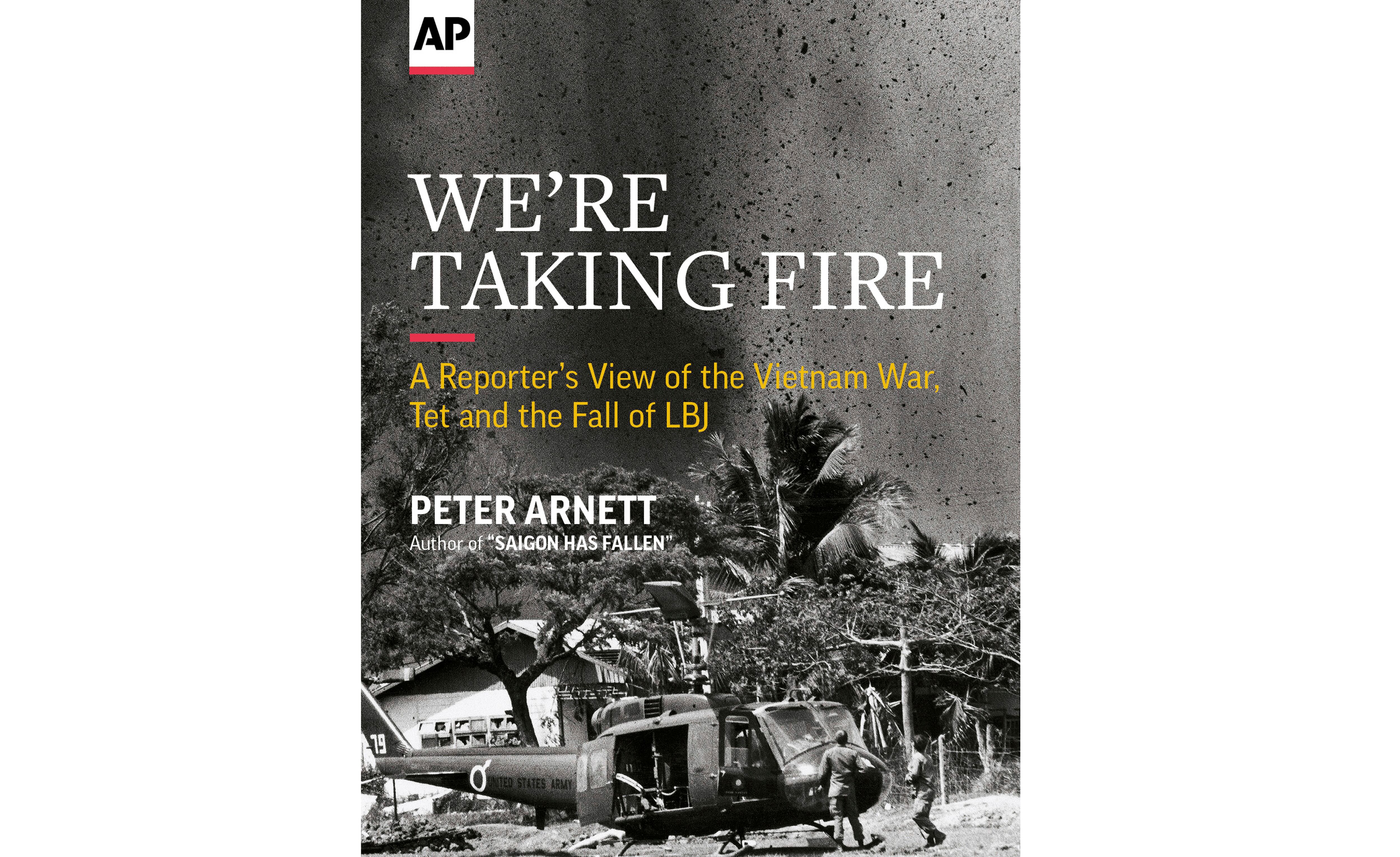
Harry McPherson was a special counsel for President Johnson who served in his administration from 1965 to 1969 and was with him in the White House as the Tet Offensive ran its course. He reflected on the rapidly growing controversies in the early days of the Tet Offensive battle, in an interview for the Lyndon Johnson Presidential Library in Austin, Texas.
“There were competing views and opposing phenomena all over the place,” he said. “The embassy in Saigon and the military operation in Saigon were telling us that we had really beat the hell out of the enemy and they have taken tremendous casualties. They lost an enormous number of people including some of their best people. They surfaced a lot of assets, to use a military phrase. A lot of people who were in the infrastructure in South Vietnam and living apparently normal lives while being VC agents came out into the open and were either killed, captured or at least identified and chased out of their villages. They (the enemy) lost a lot; they did not achieve what they expected to achieve or hoped to achieve at the outset. The South Vietnamese did get a momentary shot in the arm; they did work harder. When it was over they got together more effectively. A number of citizens efforts were begun for the first time. All of this was a plus.
“The negative was tremendous and was underplayed by Saigon. The negative was essentially here in this country. It was the feeling on the part of vast numbers of Americans, particularly after Westmoreland and Bunker had come back in the fall of the previous year and said things were just looking really good. I believe they used the expression ‘light at the end of the tunnel.’ After all of that, and after a tremendous commitment for three years — air power, 550,000 men, and all the rest of it — that this crowd (the Vietcong) was still able to mount a major offensive that smashed into cities and secure hamlets and such things. That they were able to hold Hue for a long time while the U.S. Marines encircled them. They were able to get into Saigon and terrorize the population, all that, and the awful picture you may remember of General Loan, the national police chief, executing a VC on the street.
“The terrible quality of the war in Vietnam came home to people. It appeared that these guys didn’t want to quit at all and were never going to quit, and that our crowd was as caught off guard as ever.”
“We’re Taking Fire” by Peter Arnett is exclusively available at Amazon.com.




